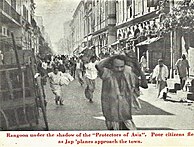
The Curtiss P-40 Warhawk is an American single-engined, single-seat, all-metal fighter-bomber that first flew in 1938. The P-40 design was a modification of the previous Curtiss P-36 Hawk which reduced development time and enabled a rapid entry into production and operational service. The Warhawk was used by most Allied powers during World War II, and remained in frontline service until the end of the war. It was the third most-produced American fighter of World War II, after the North American P-51 Mustang and Republic P-47 Thunderbolt; by November 1944, when production of the P-40 ceased, 13,738 had been built, all at Curtiss-Wright Corporation's main production facilities in Buffalo, New York.

The Brewster F2A Buffalo is an American fighter aircraft which saw service early in World War II. Designed and built by the Brewster Aeronautical Corporation, it was one of the first U.S. monoplanes with an arrestor hook and other modifications for aircraft carriers. The Buffalo won a competition against the Grumman F4F Wildcat in 1939 to become the U.S. Navy's first monoplane fighter aircraft. Although superior to the Grumman F3F biplane it replaced, and the early F4Fs, the Buffalo was largely obsolete when the United States entered the war, being unstable and overweight, especially when compared to the Japanese Mitsubishi A6M Zero.

The First American Volunteer Group (AVG) of the Republic of China Air Force, nicknamed the Flying Tigers, was formed to help oppose the Japanese invasion of China. Operating in 1941–1942, it was composed of pilots from the United States Army Air Corps (USAAC), Navy (USN), and Marine Corps (USMC), and was commanded by Claire Lee Chennault. Their Curtiss P-40B Warhawk aircraft, marked with Chinese colors, flew under American control. Recruited under President Franklin Roosevelt's authority before Pearl Harbor, their mission was to bomb Japan and defend the Republic of China, but many delays meant the AVG first flew in combat after the US and Japan declared war.
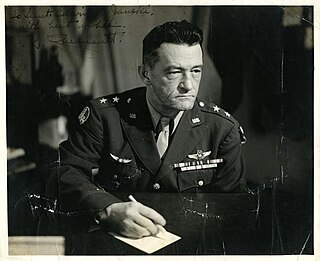
The American Volunteer Groups were volunteer air units organized by the United States government to aid the Nationalist government of China against Japan in the Second Sino-Japanese War. The only unit to actually see combat was the 1st AVG, popularly known as the Flying Tigers.

The Kawasaki Ki-61 Hien is a Japanese World War II fighter aircraft. Used by the Imperial Japanese Army Air Service, it was designated the "Army Type 3 Fighter" (三式戦闘機). Allied intelligence initially believed Ki-61s were Messerschmitt Bf 109s and later an Italian Macchi C.202, which led to the Allied reporting name of "Tony", assigned by the United States War Department. The design originated as a variant of the Kawasaki Ki-60, which never entered production. The Ki-61 became the only mass-produced Japanese fighter of the war to use a liquid-cooled inverted V engine. Over 3,000 Ki-61s were produced. Initial prototypes saw action over Yokohama during the Doolittle Raid on 18 April 1942, and continued to fly combat missions throughout the war.

The Mitsubishi Ki-67Hiryū was a twin-engine bomber produced by Mitsubishi Aircraft Company and used by the Imperial Japanese Army Air Service and Imperial Japanese Navy Air Service in World War II. While its original official designation was "Army Type 4 Heavy Bomber", in all of its key parameters, the Ki-67 was similar to the contemporaneous medium bombers of other countries. Japanese Navy variants included the P2M and Q2M.

The Kawasaki Ki-45 Toryu was a two-seat, twin-engine heavy fighter used by the Imperial Japanese Army in World War II. The army gave it the designation "Type 2 Two-Seat Fighter"; the Allied reporting name was "Nick". Originally serving as a long-range escort-fighter, the design — as with most heavy fighters of the period — fell prey to smaller, lighter, more agile single-engine fighters. As such, the Ki-45 instead served as a day and nighttime interceptor and strike fighter.

The Central Aircraft Manufacturing Company, also known as the Loiwing Factory (雷允飛機製造廠) after they moved to Yunnan, was a Chinese aircraft manufacturer established by American entrepreneur William D. Pawley in the 1930s.
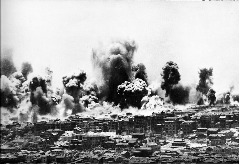
The bombing of Chongqing, from 18 February 1938 to 23 August 1943, were massive terror bombing operations authorized by the Empire of Japan's Imperial General Headquarters and conducted by the Imperial Japanese Army Air Service (IJAAF) and Imperial Japanese Navy Air Service (IJNAF). Resistance was put up by the Chinese Air Force and the National Revolutionary Army's anti-aircraft artillery units in defense of the provisional wartime capital of Chongqing and other targets in Sichuan.
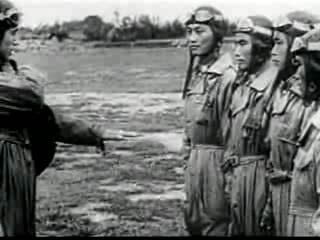
The Second Sino-Japanese War began on 7 July 1937 with the Marco Polo Bridge Incident in the Republic of China and is often regarded as the start of World War II as full-scale warfare erupted with the Battle of Shanghai, and ending when the Empire of Japan surrendered to the Allies in August 1945. The Chinese Air Force faced the Imperial Japanese Army and Navy Air Forces and engaged them in many aerial interceptions, including the interception of massed terror-bombing strikes on civilian targets, attacking on each other's ground forces and military assets in all manners of air-interdiction and close-air support; these battles in the Chinese skies were the largest air battles fought since World War I, and featured the first-ever extensive and prolonged deployment of aircraft carrier fleets launching preemptive strikes in support of expeditionary and occupational forces, and demonstrated the technological shift from the latest biplane fighter designs to the modern monoplane fighter designs on both sides of the conflict.

The Mitsubishi Ki-21, formal designation "Type 97 Heavy Bomber" was a Japanese heavy bomber during World War II. It began operations during the Second Sino-Japanese War participating in the Nomonhan Incident, and in the first stages of the Pacific War, including the Malayan, Burmese, Dutch East Indies and New Guinea Campaigns. It was also used to attack targets as far-flung as western China, India and northern Australia. The Allies designated it under the reporting names "Sally" /"Gwen".
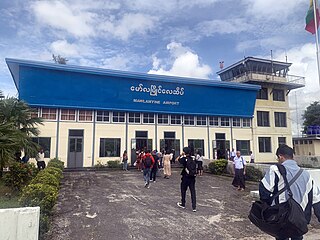
Mawlamyine Airport is an airport in Mawlamyine (Moulmein), Myanmar.

No. 60 Squadron of the Royal Air Force was formed in 1916 at Gosport. It is currently part of No. 1 Flying Training School based at RAF Shawbury in Shropshire flying the Airbus H135 Juno HT.1.

Frank Reginald "Chota" Carey, was a Royal Air Force (RAF) fighter pilot and flying ace who served during World War II.

The bombing of Singapore was an attack on 8 December 1941 by seventeen G3M Nell bombers of Mihoro Air Group, Imperial Japanese Navy, flying from Thu Dau Mot in southern Indochina. The attack began at around 0430, shortly after Japanese forces landed on Kota Bharu, Kelantan in northern Malaya. It was the first knowledge the Singapore population had that war had broken out in the Far East.
No. 62 Squadron of the Royal Air Force was originally established as a Royal Flying Corps squadron in 1916 and operated the Bristol F2B fighter in France during the last year of the First World War. After the war the squadron was disbanded and it was re-established in 1937 as part of the buildup of the RAF in the late 1930s. During the Second World War the Squadron was deployed to the Far East, operating the Bristol Blenheim from Singapore and Malaya. In 1942 No. 62 Squadron was re-equipped with the Lockheed Hudson and it moved to Sumatra, then Burma and then India. After the close of World War II the squadron disbanded for the second time. It was briefly re-established from 1946 to 1947 as a Dakota squadron and operated out of Burma and India. It final incarnation was as a Bristol Bloodhound missile unit in the early 1960s.

Aerial ramming or air ramming is the ramming of one aircraft with another. It is a last-ditch tactic in air combat, sometimes used when all else has failed. Long before the invention of aircraft, ramming tactics in naval warfare and ground warfare were common. The first aerial ramming was performed by Pyotr Nesterov in 1914 during the First World War. In the early stages of World War II the tactic was employed by Soviet pilots, who called it taran, the Russian word for "battering ram".
The Fourth Air Army was a land-based aviation force of the Imperial Japanese Army. Formed in Rabaul in June 1943, consisting of the 6th and 7th Air Divisions. The air army was responsible for covering the Solomon Islands, Dutch New Guinea and the Territories of Papua and New Guinea areas of operations. The headquarters was at Rabaul. Disestablished in January 1945.
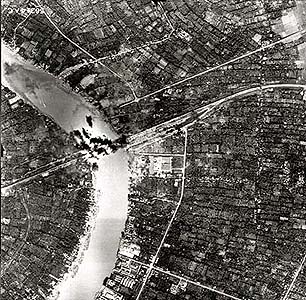
The city of Bangkok, Thailand was bombed by the Allies on numerous occasions during World War II. It was also the target for the first combat mission by Boeing B-29 Superfortresses in June 1944.

John Van Kuren "Scarsdale Jack" Newkirk was a United States naval aviator and squadron leader with the 1st American Volunteer Group (AVG), also known as the Flying Tigers, who may have led the first American offensive mission of World War II. Most of his combat experience was during the defense of Rangoon, Burma, from Japanese air attacks. After the fall of Rangoon, his unit was operating from within China when he set off on his final mission, as part of an attack on Japanese airfields in Thailand.


